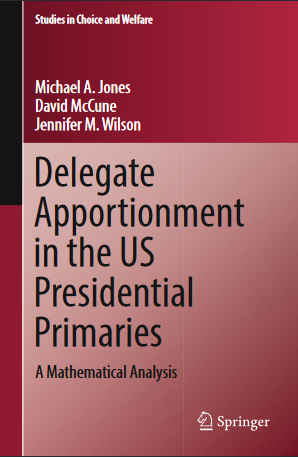موضوعات
آموزش و پرورش
ادبیات و زبان
پزشکی، دندانپزشکی و داروسازی
تاریخ و جغرافیا
داستان و رمان
دیگر
دین و فلسفه
روانشناسی
ریاضیات و آمار
سلامتی، تناسب اندام و رژیم غذایی
شیمی و پلیمر
علوم اجتماعی و حقوق
علوم زیستی و بیوتکنولوژی
فیزیک و نجوم
کامپیوتر و اینترنت
کتابهای کودکان و داستان
کسب و کار و اقتصاد
کشاورزی و دامپزشکی و غذا
معماری
مهندسی و فناوری
هنر و تئاتر
محصولات
Delegate Apportionment in the US Presidential Primaries A Mathematical Analysis - Original PDF
نویسندگان: خلاصه: The purpose of this book is to examine the mathematics of the delegate allocation process in the US presidential primaries. The US presidential primaries are a series of state elections held every four years that determine the Democratic and Republican Parties’ nominees for president in the general election. Presidential candidates in each party are awarded delegates based on their shares of the vote in each state contest. At the end of the primary season, each party holds a national convention. The candidate with a majority of state delegates, after one or more rounds of voting, is selected to be the party’s nominee for president. From a mathematical standpoint, the question of how to allocate delegates is largely a problem of apportionment. Apportionment problems arise when a fixed quantity (such as a number of delegates) must be divided among several constituents (such as candidates) in proportion to some attribute (such as vote share), so that each portion is a whole number. Since delegates are individuals and cannot be divided, their allocation is a matter of apportionment. Apportionment or similar allocation problems occur at multiple stages in the delegate selection process from determining how many delegates each state receives, and how they should be divided between statewide and district delegates, to determining what happens after each primary when the delegates must be awarded to the candidates based on how well they do in the election. Apportionment has been well-studied in the context of allocating state represen- tatives to the US House of Representatives in proportion to state populations. It has also been widely analyzed for its role in proportional representation systems where party seats are awarded to parties based on the vote distribution. It is less well-known in the case of apportioning delegates in the US primaries. Thus the examination of apportionment applied to delegate allocation involves both an identification and anal- ysis of new apportionment methods as well as an evaluation of old and new criteria by which to evaluate their properties. The goal of this book is to do both. We have spent several years researching delegate allocation in presidential primaries and were inspired to write this volume because of the interesting aspects of apportionment arising in this context. The book’s vii viii Preface origin can be traced to 2016, when we observed that the 2016 Georgia Repub- lican party adopted an apportionment method for its state primary that was unique and perhaps the most interesting method we had encountered. This motivated us to investigate the methods used by other state parties, many of which are new, and to consider how the allocation of delegates is affected by elimination thresholds—the minimum levels of support required to receive delegates—and the overall structure of the state delegates selection plans in which delegates are apportioned based on vote distributions in each district and statewide. This led us also to consider how the goals of delegate apportionment differ from that of house or party apportionment— most noticeably in that the state primaries occur over time, and that the end result is not political representation but the declaration of a winner. This means that the usual criteria for evaluating apportionment need to be rethought in an effort to deter- mine what features of traditional apportionment theory are most relevant to delegate apportionment and which features are not.آیا کتاب مورد نظر هنوز بر روی سایت قرار نگرفته است؟ جای نگرانی نیست! کافی است بر روی گزینه سفارش کتاب کلیک کرده و درخواست خود را ثبت کنید. در کمتر از چند ساعت کتاب شما را آماده خواهیم کرد.
